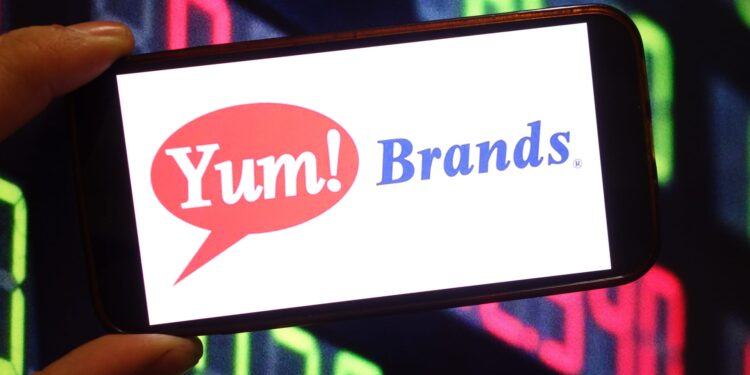Yum Brands on Tuesday reported quarterly earnings and revenue that missed analysts’ expectations as Pizza Hut and KFC reported U.S. same-store sales declines.
Here’s what the company reported for the period ended June 30 compared with what Wall Street was expecting, based on a survey of analysts by LSEG:
- Earnings per share: $1.44 adjusted vs. $1.46 expected
- Revenue: $1.93 billion vs. $1.94 billion expected
Yum reported second-quarter net income of $374 million, or $1.33 per share, up from $367 million, or $1.28 per share, a year earlier.
Excluding refranchising gains and other items, the company earned $1.44 per share.
Net sales climbed 10% to $1.93 billion. Digital transactions, which include mobile app, delivery and kiosk orders, accounted for 57% of the company’s system sales.
Yum’s same-store sales, which only tracks the metric at restaurants open at least 12 months, rose 2% during the quarter.
“I’m proud that Yum Brands delivered another strong quarter in a tough consumer environment,” CEO David Gibbs said on his final conference call before his retirement. CFO Chris Turner will succeed him as chief executive on Oct. 1.
For the second quarter, KFC reported same-store sales growth of 2%, lifted by its international restaurants. The fried chicken chain counts China as its biggest market.
But domestically, KFC’s struggles continue. Its U.S. same-store sales slid 5%. Last year, the chain dropped from the No. 3 chicken chain in the U.S. by sales to No. 5, falling behind Raising Cane’s and Wingstop.
Executives said Tuesday that KFC’s value messaging and new menu items haven’t resonated with consumers.
Yum has responded by shaking up the chain’s leadership; in March, Scott Mezvinsky took the reins as KFC’s CEO, and in April, Catherine Tan-Gillespie took over as president of KFC U.S.
Globally, Pizza Hut’s same-store sales fell 1%, hurt by weaker demand in its home market. Like KFC, Pizza Hut saw its U.S. same-store sales fall 5% during the quarter. The chain is facing increased competition from its rivals as many consumers dine out less often.
Gibbs said that Pizza Hut’s U.S. sales also faltered because of an “insufficient value message,” but the chain’s leadership is already addressing that with new promotions.
Taco Bell, the jewel of Yum’s portfolio, reported same-store sales growth of 4%, helped by the reintroduction of its Crispy Chicken Nuggets and the launch of new Crispy Chicken products.
Taco Bell’s chicken sales have climbed 50% over the last two years, according to Gibbs. The chain has also been gaining market share from fast-casual restaurants and fast-food rivals.
“Most people are reporting negative quarters. We haven’t even had a negative week for Taco Bell,” Gibbs said.
Still, Wall Street had higher expectations for Taco Bell. Analysts were projecting that the chain would report global same-store sales growth of 5.2%, based on StreetAccount estimates.
Taco Bell’s growing international business reported a same-store sales increase of 4% during the quarter.
Yum’s total restaurant count rose 3%, lifted by 871 location openings in the quarter. That growth was driven primarily by international KFC openings.













